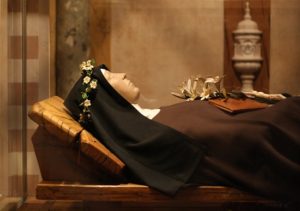St. Clare of Assisi was one of the first women Franciscans and founder of a worldwide order of contemplative sisters, choosing to leave a comfortable, wealthy life behind to live one of poverty and prayer.
Clare was born into a rich family in Assisi in 1194. Her father worked for royalty, and the family lived in a lavish home in the hills of Assisi. Her mother was a devout woman who was devoted to prayer and service to the poor.
When she was 19, Clare heard St. Francis of Assisi speak at a Lenten service and her life was changed. Inspired to follow him, she snuck out of her family’s house on the evening of Palm Sunday, 1212, and stole away to meet Francis in a chapel in Poziuncula. There, she cut off her hair and traded her expensive clothes for simple garb and veil. Francis sent Clare to the Benedictine convent in San Paulo to begin her life in service to God.

When her father discovered what Clare had done, he and other family members tried to invade the convent to bring Clare home. However, she refused to return to her family, saying she would have no other spouse than Jesus Christ.
Francis decided to send Clare to another Benedictine convent in Panzo to calm the situation. She was joined weeks later by her sister, Catarina (who took the name Agnes and was later also canonized). Together with several other women, they received a Rule for their order from Francis, and were named Second Order Franciscans. They later moved to a convent in San Damiano.
The sisters’ lifestyle was simple: austere living combined with a powerful prayer life. They were known as the Order of Poor Ladies and lived a life of extreme poverty. They wore no shoes, ate no meat, performed manual labor, slept on the floor, kept silence, and spent much time in prayer. Clare soon became Abbess of the order.
Many times over the years local church authorities tried to get the sisters to cut back on the extremes of their simple lifestyle and follow the Rule of Benedict instead, but the sisters refused. Pope Gregoy IX tried to once offer Clare dispensation from the vow of extreme poverty, but she told him, “I need to be absolved from my sins, but not from the obligation of following Christ.”
Although they lived a cloistered life, the sisters were not meek in the face of danger. In 1224, an army came to attack the town of Assisi. Stories say that Clare went out to meet the invaders holding the Blessed Sacrament and begged God to protect them, saying, “Does it please you, O God, to deliver into the hands of these beasts the defenseless children I have nourished with your love? I beseech you, dear Lord, protect these whom I am now unable to protect.” The army left without attacking. Clare is often depicted in art holding a pyx as a symbol of that event.
In her later years, Clare was sickly, but received many visitors at the convent. She could not attend Mass, but recounted once that she could see and hear the Mass on the wall of her room. Because this unusual event sounded so much like a broadcast, it’s believed to be the reason Pope Pius XII named Clare the patron saint of television in 1958.
Clare died on Aug. 11, 1253 at age 59. Just a few days later, Pope Innocent declared that her Rule would be the governing one for her order, who were eventually known as the Poor Clares. Her cause for canonization began immediately. Clare was declared a saint in 1255 by Pope Alexander IV. She is interred in the Basilica of St. Clare in Assisi.
St. Clare of Assisi’s feast day in Aug. 11.
She is the patron of eye disease, goldsmiths, laundry, television, and needlepoint workers.
Read her biography from Franciscan Media here:https://www.franciscanmedia.org/saint-clare-of-assisi/
Learn more about the Poor Clares here:
“Our labor here is brief, but the reward is eternal. Do not be disturbed by the clamor of the world, which passes like a shadow. Do not let false delights of a deceptive world deceive you.”
― St. Clare of Assisi








